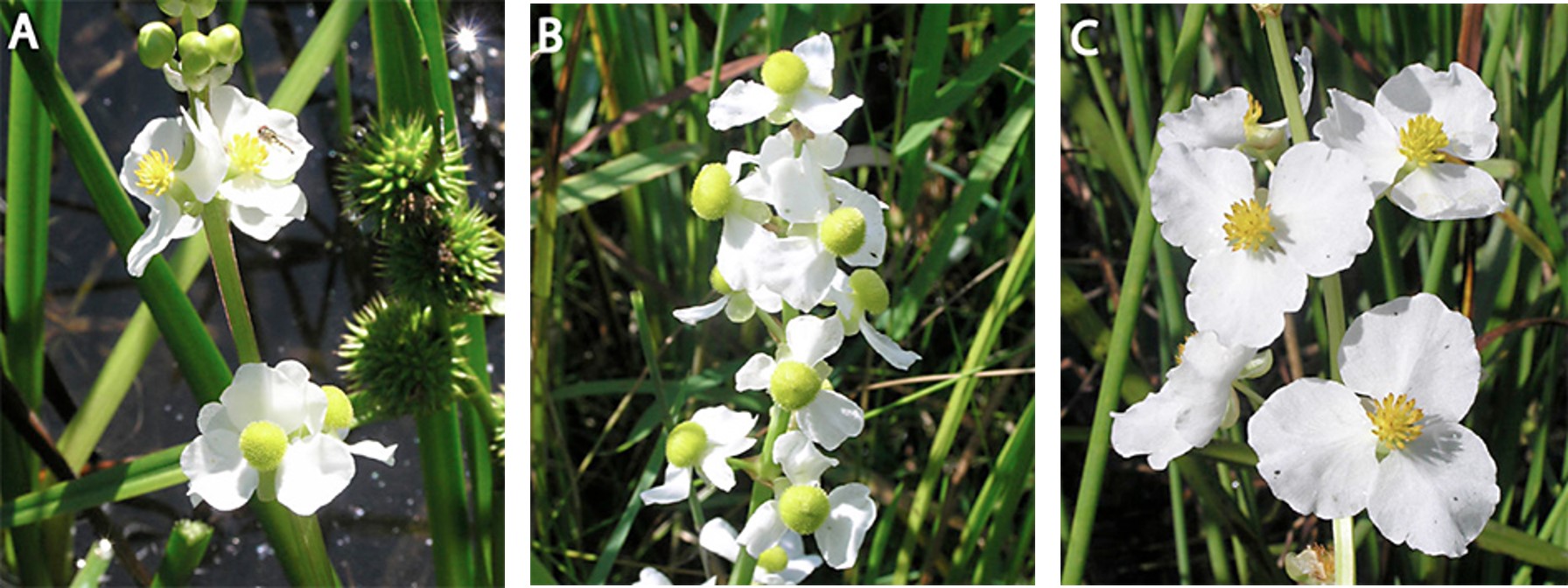
Floral diversity in insect-pollinated Wurmbea (Colchicaeae) species. Populations of these species are either monomorphic or dimorphic for gender.
Gender strategies and the evolution of sex ratios
I have a long-standing interest in gender strategies, and in trying to understand the costs and benefits of combined versus separate sexes. Earlier work involved studies of Aralia (16, 18) and Wurmbea (179, 227) but more recently we have concentrated our efforts on the clonal, aquatic plant genus Sagittaria, particularly S. latifolia. This species is common in eastern N. America and populations are mostly either monoecious or dioecious and occupy different wetland habitats. Although plants of the two sexual systems are fully inter-fertile, there is little gene flow between them over most of their range because of ecological and life-history differentiation. We have exploited the intra-specific variation in sexual systems of S. latifolia in an effort to understand the ecological and genetic mechanisms responsible for the evolution and maintenance of dioecy (177, 184, 198, 205, 216, 257 267).

Inflorescences of hermaphrodite, female and male plants of Sagittaria latifolia (Alismataceae)
We have also worked on the problem of sex ratio bias in dioecious populations. Former PDFs David Field and Melinda Pickup investigated the ecological and life history correlates of biased sex ratios in dioecious species (294). In addition, we have been working on Rumex species, a group of wind-pollinated herbs characterized by female biased sex ratios. We are interested in determining the mechanisms responsible for this female bias, which is less common in flowering plants than male bias. Working with R. nivalis, former PDF Ivana Stehlik demonstrated that bias results from both microgametophyte selection and gender based differences in mortality (223, 226, 233, 249). This work was greatly facilitated by the development of sex–specific markers. We are now exploring sexual dimorphism and the mechanisms governing female bias in R. hastatulus, an annual species native to the southern USA ranging in distribution from Texas to North Carolina.
PDF Joanna Rivkin is working with me and my colleague Stephen Wright in EEB on several problems concerned with sex chromosome evolution in Rumex hastatulus (377, 383). This species is an excellent model system because it is annual, very easy to grow and cross, and we also have a broad sampling of geographical variation. The species is of particular interest because it possesses two distinct mechanisms of sex determination. In populations from the western portion of the range females are XX and males are XY, whereas in eastern populations females are XX and males are XYY. Phylogenetic evidence indicates that species in the genus with two Y-chromosomes are derived from those with a single Y. We are interested in investigating various aspects of the molecular population genetics and molecular evolution of X- and Y-chromosomes in this group. This will be achieved by obtaining sex-linked markers using genomic approaches and high throughput sequencing. Specifically, we will investigate the hypothesis of Y-chromosome degeneration and reduced effective population size of the Y-chromosome resulting from suppression of recombination and the fixation of deleterious mutations.

Rumex nivalis and R. hastatulus (Polygonaceae), dioecious wind-pollinated species with female-biased sex ratios
